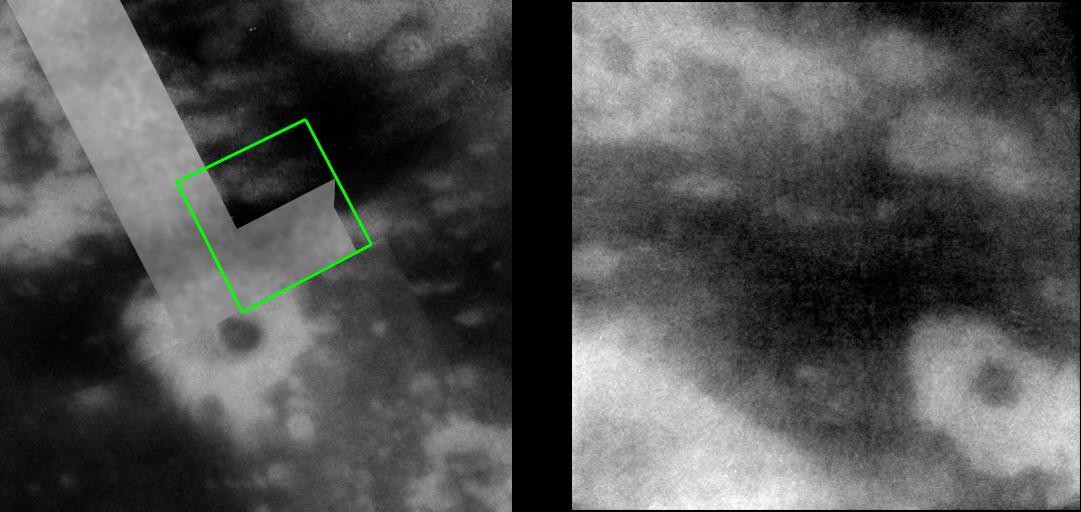Dark Spots on Titan

| PIA Number | PIA06234 |
|---|---|
| Language |
|
This recent image of Titan reveals more complex patterns of bright and dark regions on the
surface, including a small, dark, circular feature, completely surrounded by brighter material.
During the two most recent flybys of Titan, on March 31 and April 16, 2005, Cassini captured a
number of images of the hemisphere of Titan that faces Saturn. The image at the left is taken
from a mosaic of images obtained in March 2005 (see Titan Mosaic - East of Xanadu) and shows the location of the
more recently acquired image at the right. The new image shows intriguing details in the bright
and dark patterns near an 80-kilometer-wide (50-mile) crater seen first by Cassini's synthetic
aperture radar experiment during a Titan flyby in February 2005 (see Impact Crater with Ejecta Blanket) and
subsequently seen by the imaging science subsystem cameras as a dark spot (center of the image
at the left).
Interestingly, a smaller, roughly 20-kilometer-wide (12-mile), dark and circular feature can be
seen within an irregularly-shaped, brighter ring, and is similar to the larger dark spot associated
with the radar crater. However, the imaging cameras see only brightness variations, and without
topographic information, the identity of this feature as an impact crater cannot be conclusively
determined from this image. The visual infrared mapping spectrometer, which is sensitive to
longer wavelengths where Titan's atmospheric haze is less obscuring -- observed this area
simultaneously with the imaging cameras, so those data, and perhaps future observations by
Cassini's radar, may help to answer the question of this feature's origin.
The new image at the right consists of five images that have been added together and enhanced
to bring out surface detail and to reduce noise, although some camera artifacts remain.
These images were taken with the Cassini spacecraft narrow-angel camera using a filter sensitive
to wavelengths of infrared light centered at 938 nanometers -- considered to be the imaging
science subsystem's best spectral filter for observing the surface of Titan. This view was acquired
from a distance of 33,000 kilometers (20,500 miles). The pixel scale of this image is 390 meters
(0.2 miles) per pixel, although the actual resolution is likely to be several times larger.
The Cassini-Huygens mission is a cooperative project of NASA, the European Space Agency
and the Italian Space Agency. The Jet Propulsion Laboratory, a division of the California
Institute of Technology in Pasadena, manages the mission for NASA's Science Mission
Directorate, Washington, D.C. The Cassini orbiter and its two onboard cameras were designed,
developed and assembled at JPL. The imaging team is based at the Space Science Institute,
Boulder, Colo.
For more information about the Cassini-Huygens mission visit http://saturn.jpl.nasa.gov . For
additional images visit the Cassini imaging team homepage http://ciclops.org .
Credit: NASA/JPL/Space Science Institute
